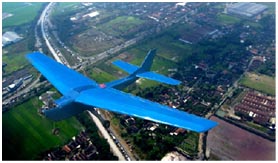 Download Tutorial Lengkap (PDF 416 KB)
Download Tutorial Lengkap (PDF 416 KB)
INTRODUCTION TO AIR AND ATMOSPHERE
GENERAL
The atmosphere of Earth is a layer of gases surrounding the planet Earth that is retained by Earths gravity. The atmosphere protects life on Earth by absorbing ultraviolet solar radiation, warming the surface through heat retention (greenhouse effect), and reducing temperature extremes between day and night.
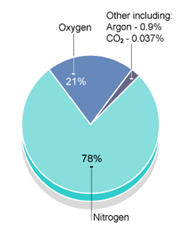
Air is mainly composed of 78% nitrogen, 21% oxygen, and argon, which together constitute the major gases of the atmosphere. Water vapor accounts for roughly 0.25% of the atmosphere by mass. The concentration of water vapor (a greenhouse gas) varies significantly from around 10 ppmv in the coldest portions of the atmosphere to as much as 5% ppmv in hot, humid air masses, and concentrations are typically provided for dry air without any water vapor. The remaining gases are often referred to as trace gases, among which are the greenhouse gases such as carbon dioxide, methane, nitrous oxide, and ozone.


ATMOSPHERE LAYERS
The atmosphere consists of five layers, held around the planet by the force of gravity. As you move upwards through the layers, atmospheric pressure decreases rapidly with height and the air temperature also changes. It is these, more complicated, changes in temperature which are used to divide the atmosphere into the layers described below.
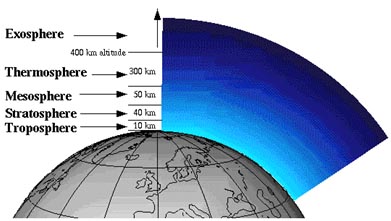
| Exosphere | Above a height of about 500km is the exosphere, a layer where the atmosphere merges into space. Satellites are stationed in this area, 500km to 1000km from Earth.
nbsp; |
| Thermosphere | The thermosphere is the fourth layer in the atmosphere, between 80km and 110km above the Earth. Space shuttles fly in this area and it is also where the aurora lights are found. Auroras are wispy curtains of light caused when the sun strikes gases in the atmosphere above the Poles.
nbsp; |
| Mesosphere | Beyond the stratosphere the air is very thin and cold. This area is known as the mesosphere, and is found between 50km and 80km above the Earth’s surface.
nbsp; |
| Stratosphere | The stratosphere is the second layer of air above the Earth’s surface and extends to a height of 50km. It is here that we find the ozone layer. The ozone layer absorbs much of the sun’s harmful radiation that would otherwise be dangerous to plant and animal life.
nbsp; |
| Troposphere | The troposphere is the layer closest to the Earth, approximately 11km high. Weather occurs only in the troposphere because it is this layer that contains most of the water vapour. Weather is the way water changes in the air, and so without water there would be no clouds, rain, snow or other weather features.
nbsp; |
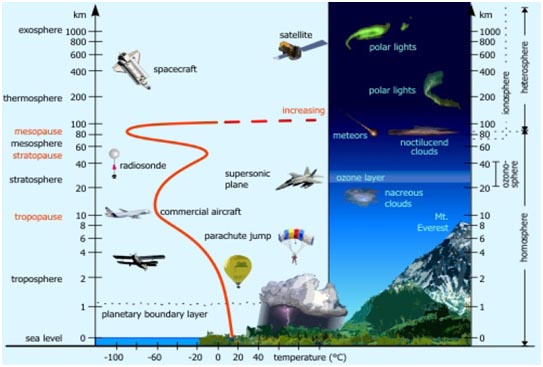
ATMOSPHERE STANDARD REFERENCE
Sea Level as Reference
To predict, calculate and compare the conditions of air at each atmosphere layers, it is requires to have an atmosphere reference condition. It is a common practice to use Sea Level as Standard Atmospheric reference conditions (pressure, density, temperature).

International Standard Atmosphere
The International Standard Atmosphere (ISA) is an atmospheric model of how the pressure, temperature, density, and viscosity of the Earths atmosphere change over a wide range of altitudes. It has been established to provide a common reference for temperature and pressure and consists of tables of values at various altitudes, plus some formulas by which those values were derived.
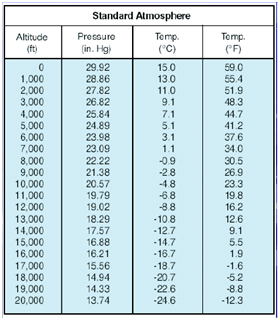
ATMOSPHERIC TEMPERATURE
Atmospheric temperature is a measure of temperature at different levels of the Earths atmosphere. It is governed by many factors, including incoming solar radiation, humidity and altitude.
In the Earths atmosphere, temperature varies greatly at different heights relative to the Earths surface. The coldest temperatures lie near the mesopause, an area approximately 85 km (53 mi) to 100 km (62 mi) above the surface.
Atmospheric temperature
1. The air temperature at sea level standard atmosphere are considered equal in the world: 15° C.
2. Any increase in 1000 feet of air temperature decreases 2° C.


AIR DENSITY
Air has mass (or weight) although small, is expressed by the mass density or density The density of air, ?, is the mass per unit volume of Earths atmosphere, and is a useful value in aeronautics and other sciences. Air density decreases with increasing altitude, as does air pressure. It also changes with variances in temperature or humidity.
Air Density
1. Air density at sea level is 1,225 kg/m3 or about 1/800 of the water density 1,000 kg/m3.
2. Growing up, the smaller the density of air.
3. At an altitude of 22 000 feet the air density is 50% of the air density at sea level.
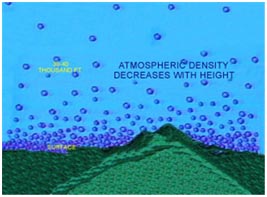
AIR PRESSURE
As we know, the air in the atmosphere is made up of a number of gases. These gases press down on the Earth’s surface, exerting a force that we call atmospheric pressure or air pressure. Although we are usually unaware of this pressure, it actually presses down very hard.
Air Pressure
1. Standard atmospheric air pressure at sea level altitude is 101 kPa or 7.14 psi.
2. The higher, the air gets tenuous.
3. At an altitude of 17,500 feet the air pressure is ½ of the air pressure at sea level.
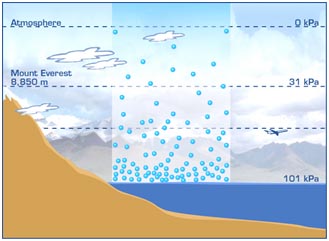
CASE STUDY
Unmanned surveillance aircraft to carry a payload of 5 kg flying at cruising altitude of 17,500 ft above sea level.
1. Estimate the temperature of the air at that altitude.
2. Estimate the air pressure at altitude.
3. Estimate the density of the air at that altitude.
